Main To Whom It May Concern Takeaways:
- To Whom It May Concern is a salutation. The salutation of a letter gives writers a chance to set the tone of your correspondence.
- Capitalize the letter of each word, then follow the phrase with a colon.
- To Whom It May Concern may also be written as To Whom This May Concern.
- Alternatives include Dear, Hello, and Greetings.
- There are pros and cons to using a generic greeting. It can minimize the risk of misspelling a name or incorrectly identifying gender. On the other hand, it can sound impersonal and imply laziness or a lack of care.
- To Whom It May Concern is appropriate for formal correspondence when you don’t know who the recipient is. This includes letters of reference, initial contact emails, and when prospecting.
You should always do everything you can to find out the recipients name and contact information. However, when this isn’t possible, use To Whom It May Concern. We’ll show you how to correctly use this salutation and look at sample letters with To Whom It May Concern in action.
What is the Correct way to Write To Whom It May Concern?
Always capitalize the first letter of every word. Then, add a colon at the end of the phrase, right after the word Concern. Next, double-space before beginning the rest of your letter.
- Capitalize the first letter of every word.
- Punctuate it with a colon after following Concern. If you’re working with a particular style guide, be sure to consult it for specific rules. Some call for a comma instead of a colon.
- Double-space before starting the body of your letter.
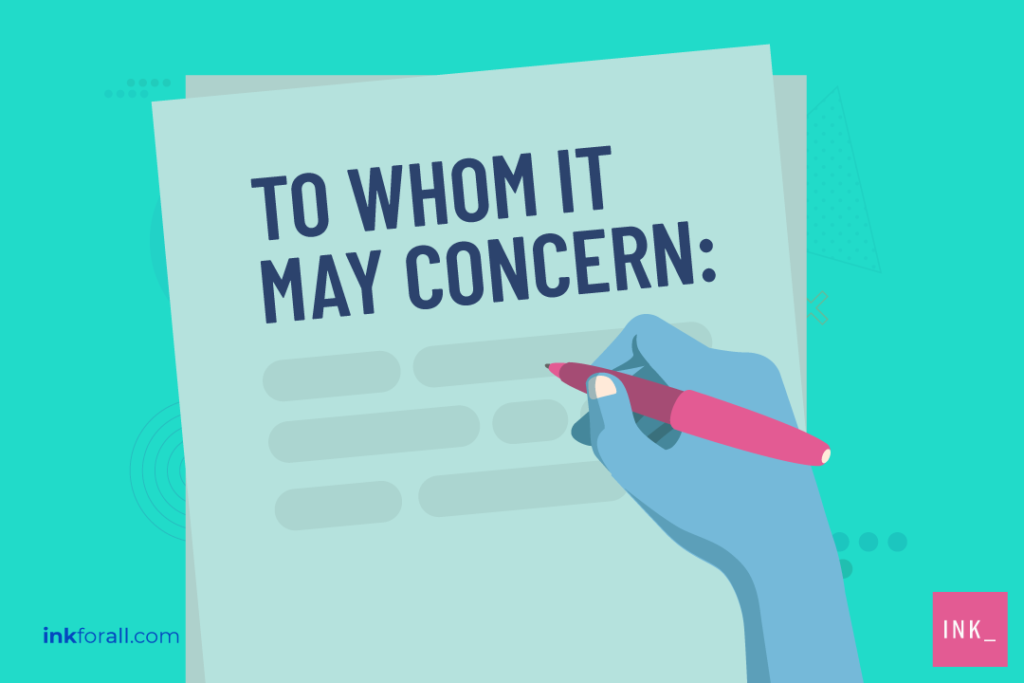

Example Letter Using To Whom It May Concern
I recently purchased a pet harness from your company’s website, and the strangest thing happened. It arrived damaged, but the damage didn’t appear to be from a shipping problem. Rather, it seemed to be chewed up. I am hoping you can help me with this, either through a replacement or a refund. I’d also love to understand how this happened!
Best Regards,
A Disappointed Dog Owner
What is the Meaning of To Whom It May Concern?
This is a traditional salutation found in formal or professional correspondence. ToWhom It May Concern is usually used when you aren’t sure of the recipient’s name or who the recipient might be. Basically, it means that you are addressing whoever is responsible for what your letter is about. “It” refers to what your letter is about. “To Whom” and “Concern” refer to the person responsible for (or concerned with) your query. “May” refers to the fact that you’re not sure who is responsible for your query.
Some feel that this common salutation is becoming obsolete. Similarly, others feel it sounds too impersonal and even stuffy. However, many letter writers wonder if this classic greeting is still appropriate and effective to use.
Is To Whom It May Concern Rude?
No, it’s not rude to use “To Whom It May Concern” in your cover letters, proposal letters, and other correspondence. That’s because this salutation works well when you are unsure of the recipient’s name and want to come across as respectful.
With that said, “To Whom It May Concern” may not be the ideal salutation in specific contexts. For example, it’s acceptable to use the salutation when lodging a customer service complaint.
Meanwhile, using “To Whom It May Concern” in your cover letter may make it come off as bland. So, while using it is appropriate in certain situations, when you have a specific name that you can address, it is best to do so.
When It’s Okay to Use To Whom It May Concern
To Whom It May Concern can still be useful at times. It’s appropriate to use this generic greeting in:
- Letters of reference or introduction.
- Initial contact forms or emails.
- Cover letters for Resumes.
- Prospecting letters.
- Any correspondence where multiple recipients will receive the same letter.
- Any time you are not sure who the recipient is.


Should I use To Whom It May Concern?
If you don’t who the recipient is, using To Whom It May Concern is fine. Alternatives include Greetings and Dear. Use these alone or in combination with the person’s job title or department. However, it all comes down to style and context. On one hand, To Whom It May Concern is a generic greeting that helps avoid addressing the wrong person, misspelling a name, or using the incorrect gender. Another benefit is that if you’re sending the same letter to multiple people, you’ll save time researching names and changing the greeting. On the other hand, it’s less personal and can seem old-fashioned. Or worse, it could come off lazy because a quick Internet search or phone call could give you the information you need to create a more personal and unique impression.
It can be difficult to start a letter if you don’t know who the recipient is. This may happen when writing business letters to a company, cover letters for resumes, and recommendations.
Pros:
- You won’t risk addressing the wrong person, misspelling a name, or incorrectly guessing a gender.
- If you’re sending copies to multiple people, you don’t have to change the greeting.
- Using To Whom It May Concern can save you time researching names.
Cons:
- Ultimately, detractors of To Whom It May Concern argue that we live in an age of information, which has rendered this generic greeting obsolete.
- It’s now possible to find the names of contacts for most companies through websites and social media accounts.
- Plus, what an internet search can’t accomplish, a quick phone call easily can.
The good news is that there are plenty of alternatives for this go-to salutation.
To Whom It May Concern Alternatives
You’ve made every effort to find the name of your contact person but in the end, you still aren’t sure.
But, you want to avoid using To Whom It May Concern. You want to stand out from the crowd and make a memorable but professional first impression.
You may also have tossed out the classic Dear Sirs since your correspondence could easily end up on the desk of a female employee. What’s left?
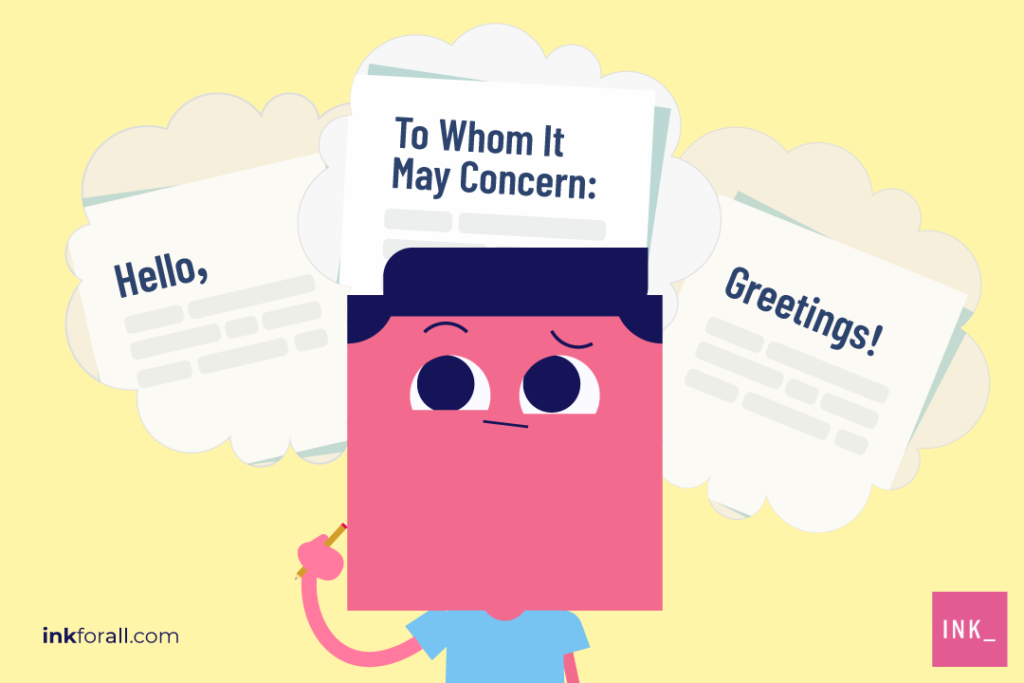

Here are the 15 best modern To Whom It May Concern alternatives:
- Hello
- Greetings
- Re: (Topic of Letter)
- Dear Sir or Madam
- Dear [Department] Name
- Dear [Department] Manager
- Dear HR Manager
- Dear Human Resources Representative
- Dear Hiring Manager
- Dear Hiring Committee
- Dear Search Committee
- Dear Recruiter
- Dear Recruiting Manager
- Dear Personnel Manager
- Dear Customer Service Manager
All of these options imply knowledge of the recipient’s name, but remember, there are plenty of ways to find your addressee on the internet.
- Search the company’s website for your contact.
- Visit the company’s social media or LinkedIn page.
- Reach out via a chat box or direct message to ask a representative who you should be writing to.
- If all else fails, a phone call should do the trick.
Let’s take a closer look at when and how you might use some of these alternatives.
Hello or Greetings
These casual salutations can be useful when writing informal correspondence, such as emails, memos, or direct messages on social media.
Use them alone or in with a name, job title, or department.
Typically, place a comma after the name or point of contact.
Some writers may opt for a colon or even a period or exclamation point to create additional emphasis. However, always consult the particular style guide you’re following.
What’s more, be sure to consider your audience. For example, exclamation points can seem very informal and are not always appropriate or appreciated.
Dear vs. To Whom It May Concern
Dear is also a classic salutation. But, is more common in modern letter-writing use thanks to its simplicity and versatility.
To properly punctuate this greeting, use Dear + Name, followed by a comma.
There are several ways you can use this traditional greeting in correspondence.
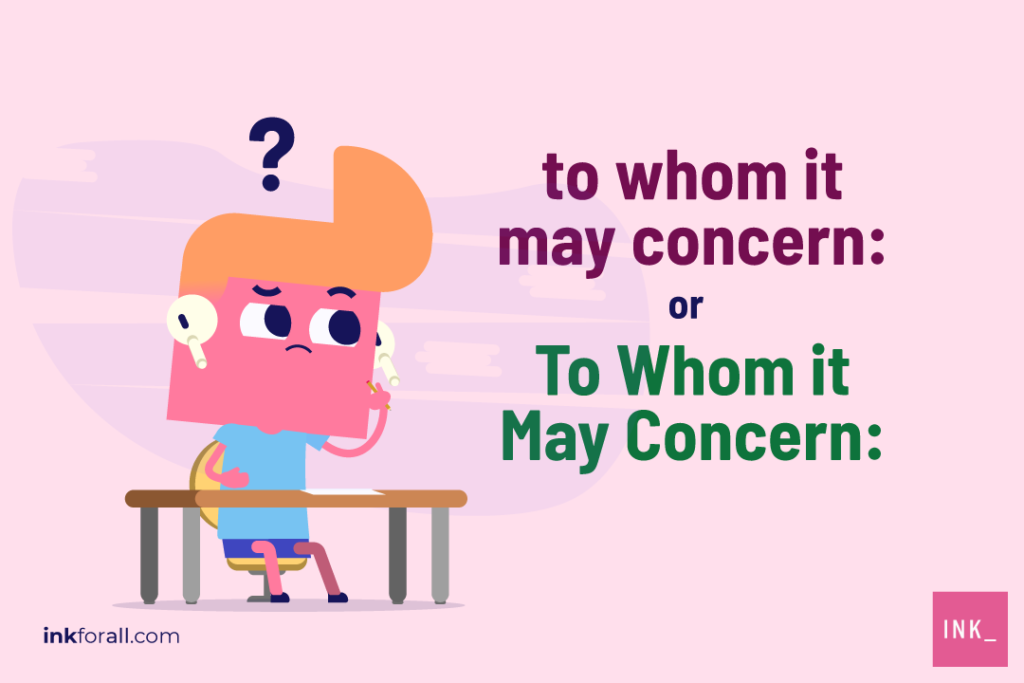

1. Dear [Name]
For informal correspondence, use a first name or even a nickname. For formal correspondence such as business letters, use the person’s title and surname. Titles, otherwise known as honorifics, may include Dr., Professor, Mrs., Mr., Ms., Miss, and the gender-neutral Mx. If your letters are aiming high, your greeting may also include royal titles such as Lord and Lady.
2. Dear [Role], [Team], or [Department]
When writing professional letters or corresponding with companies, it’s acceptable to address a letter to a department or the representative of a position.
By using a specific role, you can make sure your letter reaches the intended recipient.
Addressing a letter to a team is another effective way of personalizing a letter without using a specific person’s name.
When addressing a letter to a specific department, you increase the likelihood of it reaching someone in the know.
This is especially useful when you just can’t find the name of a person or if you know the company is in transition.
The Importance of a Salutation
When you correspond with a person or company, it’s generally for a purpose.
Letters offer a chance to connect with potential clients, employers, or employees, and can serve to notify recipients of wants, needs, or demands. They may also be a way to reach out with questions of varying levels of importance.
That’s why it’s vital to get it right when you’re writing a letter.
A salutation is a crucial part of any correspondence. With a single phrase, the writer can set the tone for the letter. It’s a chance to create that all-important first impression.
The salutation can let the reader know whether the letter will be formal or informal, friendly, or professional. It can create a sense of familiarity or show that the recipient is unknown to the sender.
Using someone’s name may also be an effective way to grab your recipient’s attention, making sure what’s said next gets read. But, when you aren’t sure who the recipient is, To Whom It May Concern is an ideal choice.
Try This Quick To Whom It May Concern Quiz
Question #1
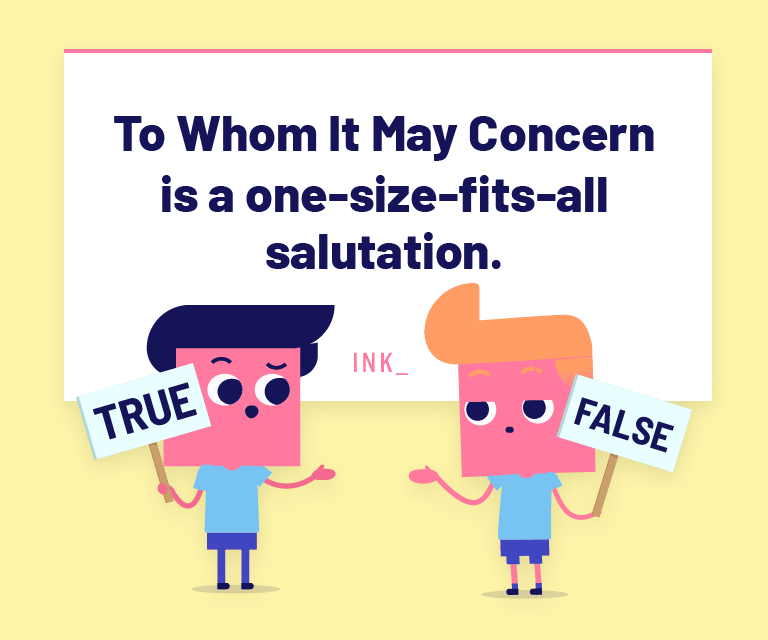

The answer is TRUE. To Whom It May Concern is a generic salutation typically used when the writer doesn’t know the recipient’s identity.
Question #2
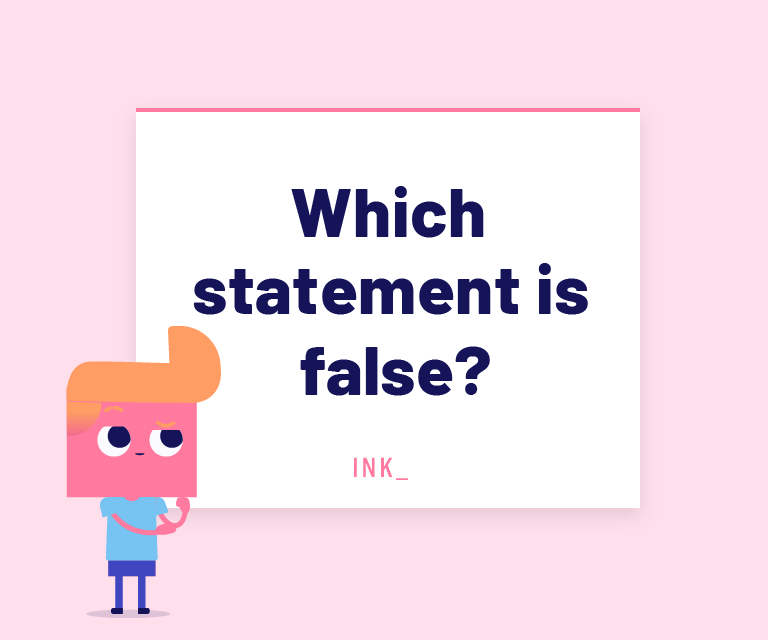

The answer is B. Since the salutation doesn’t address anyone in particular, it feels less personal.
Question #3
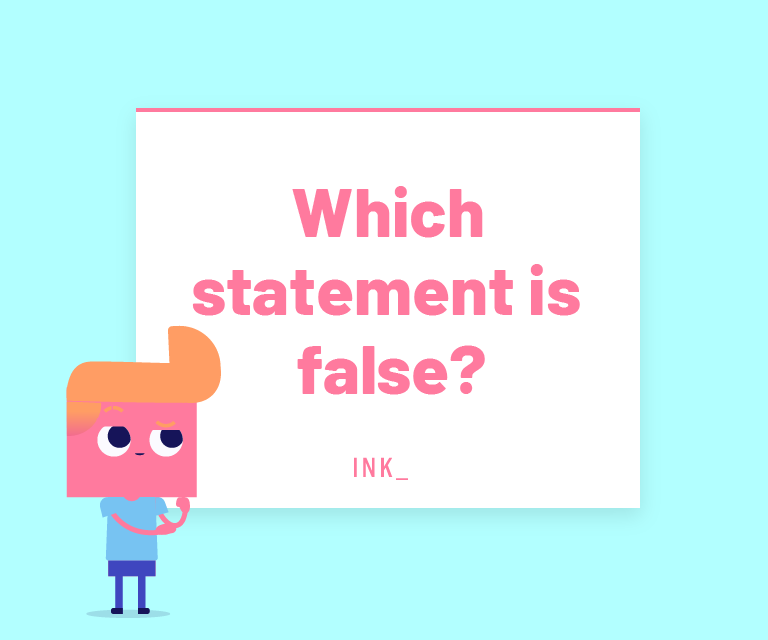

The answer is B. You can use a colon to punctuate To Whom It May Concern.
Question #4


The answer is D. All the salutations above are viable modern alternatives for To Whom It May Concern.
